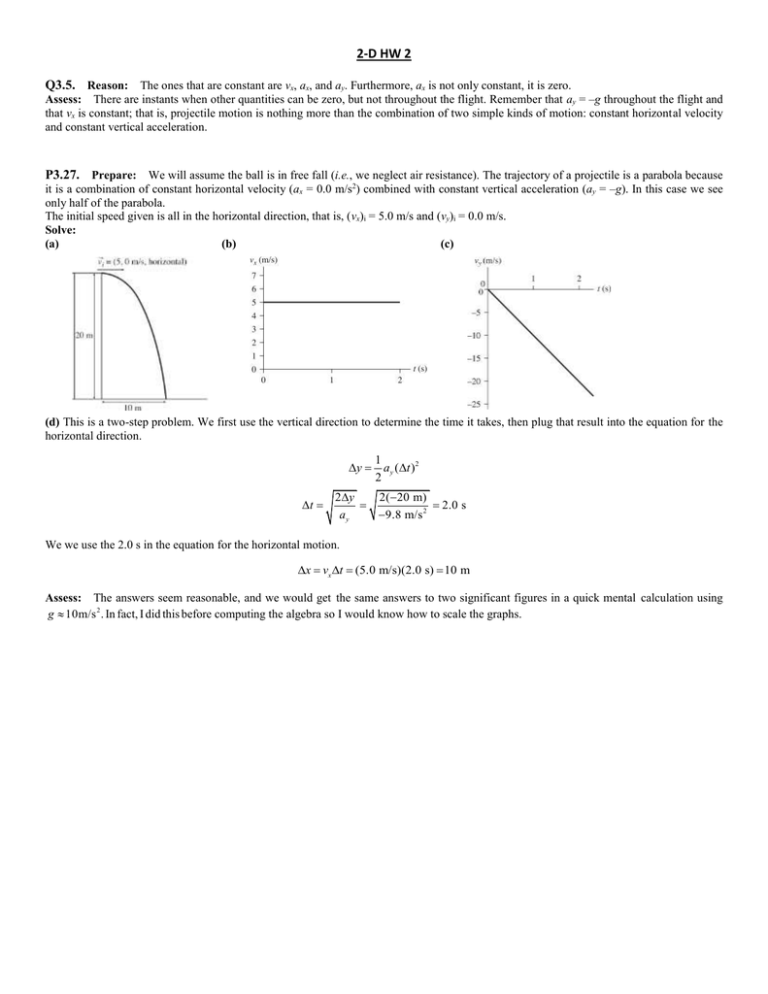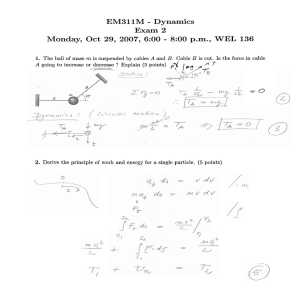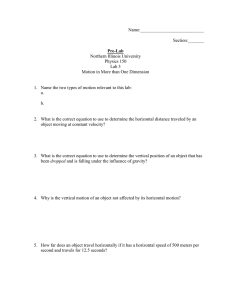2-D HW 2 Q3.5.
advertisement

2-D HW 2 Q3.5. Reason: The ones that are constant are vx, ax, and ay. Furthermore, ax is not only constant, it is zero. Assess: There are instants when other quantities can be zero, but not throughout the flight. Remember that ay = –g throughout the flight and that vx is constant; that is, projectile motion is nothing more than the combination of two simple kinds of motion: constant horizontal velocity and constant vertical acceleration. P3.27. Prepare: We will assume the ball is in free fall (i.e., we neglect air resistance). The trajectory of a projectile is a parabola because it is a combination of constant horizontal velocity (ax = 0.0 m/s2) combined with constant vertical acceleration (ay = –g). In this case we see only half of the parabola. The initial speed given is all in the horizontal direction, that is, (vx)i = 5.0 m/s and (vy)i = 0.0 m/s. Solve: (a) (b) (c) (d) This is a two-step problem. We first use the vertical direction to determine the time it takes, then plug that result into the equation for the horizontal direction. y t 2 y ay 1 a y ( t ) 2 2 2(20 m) 2.0 s 9.8 m/s 2 We we use the 2.0 s in the equation for the horizontal motion. x vx t (5.0 m/s)(2.0 s) 10 m Assess: The answers seem reasonable, and we would get the same answers to two significant figures in a quick mental calculation using g 10m/s 2 . In fact, I did this before computing the algebra so I would know how to scale the graphs. P3.28. Prepare: We can use the vertical part of the motion to calculate the time it takes the ball to hit the floor and the horizontal part of the motion to find out how far from the bench it lands. Solve: Refer to the visual overview shown. The initial vertical velocity is zero. Take the floor as the origin of coordinates. The ball falls from yi = 1.00 m and lands at yf = 0 m. (a) We can use the vertical-position equation from Equations 3.25 to find the time it takes the ball to reach the floor. yf yi (vy )i t 1 g ( t ) 2 2 1 0.00 m 1.00 m (9.80 m/s 2 )( t ) 2 2 Solving for t , t 2( 1.00m) 0.452s 9.80m/s 2 (b) The distance the ball travels horizontally is governed by the horizontal-position equation from Equations 3.25. xf xi (vx )i t (1.25 m/s)(0.452 s) = 0.565 m Assess: This seems reasonable. Compare to Example 3.11 in the text, which is similar. P3.30. Prepare: We will apply the constant-acceleration kinematic equations to the horizontal and vertical motions as described by Equations 3.25. Solve: Using yf A yiA (vy )i A (tfA tiA ) 12 (ay )A (tfA tiA )2 , we get 1.0 m 0 m 0 m 12 ( 9.8 m/s 2 )(tfA 0s) 2 tfA 0.452 s tf B Because yfA = y fB, so both take the same time to reach the floor. We are now able to calculate xfA and xfB as follows: xfA xiA (vx )i A (tfA tiA ) 12 ( ax ) A (tfA tiA ) 2 0 m (5.0 m/s)(0.452 s 0 s) 0 m 2.3 m xfB xiB (vx )i B (tfB tiB ) 12 (ax ) B (tfB tiB ) 2 0 m (2.5 m/s)(0.452 s 0 s) 0 m 1.1 m Assess: Note that tfB = tfA since both the spheres move with the same vertical acceleration and both of them start with zero vertical velocity. The horizontal distance for sphere B is one-half the distance for sphere A because the horizontal velocity of sphere B is one-half that of A.




